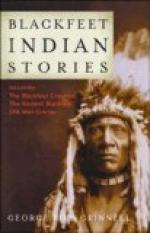Most of the meat cooked for the family was roasted, yet much of it was boiled, sometimes in a bowl of stone, sometimes in a kettle made of a fresh hide or of the paunch of the buffalo. Sometimes these skin or paunch kettles were supported at the sides by stakes stuck in the ground, and sometimes a hole dug in the ground was lined with the hide, which was so arranged as to be water-tight. They were not, as may be imagined, put over a fire, but when filled with cold water this water was heated in quite another way. Near by a fire was built, in which were thrown large stones, and on top of the stones more wood was piled; so that after a time, when the wood had burnt down, the stones were very hot—sometimes red hot. With two rather short-handled forked sticks, the women took from the fire one of the hot stones, and put it in the water in the hide kettle, and as it cooled, took it out and put in another hot stone. Thus the water was soon heated, and boiled and cooked whatever was in the kettle. To be sure, there were some ashes and a little dirt in the soup, but that was not regarded as important.
This was long before the Indians knew of matches, or even of flint and steel. In those days to make a fire was not easy and it took a long time. By his knees or feet a man held in position on the ground a piece of soft, dry wood in which two or three little hollows had been dug out, and taking another slender stick of hard wood, and pressing the point in one of the little hollows in the stick of soft wood, he twirled the stick rapidly between the palms of his hands, so fast and so long that presently the dust ground from the softer stick, falling to one side in a little pile, began to smoke, and at last a faint spark was seen at the top of the pile, which began to glow, and, spreading, became constantly larger. He, or his companion, for often two men twirled the stick, one relieving the other, caught this spark in a bit of tinder—perhaps some dry punk or a little fine grass—and by blowing coaxed it into flame, and there was the fire.
This fire making was hard work, and the people tried to escape this work by keeping a spark of fire always alive. To do this, men sometimes carried, by a thong slung over the shoulder, the hollow tip of a buffalo horn, the opening of which was closed by a wooden plug. When going on a journey, the man lighted a piece of punk, and, placing it in this horn, plugged up the open end, so that no air could get into the horn. There the punk smouldered for a long time, and neither went out nor was wholly consumed. Once in a while during the day the man looked at this punk, and, if he saw that it was almost consumed, he lighted another piece and put it in the horn and replaced the plug. So at night when he reached camp the fire was still in his horn, and he could readily kindle a blaze, and from this blaze other fires were kindled. Often, if the camp was large, the first young men who reached it gathered wood and perhaps kindled four fires, and after the women had reached the camp, unpacked their dogs, and put up their lodges, each woman would go to one of these fires to get a brand or some coals with which to start her own lodge fire.




